Human Orbital Spaceflights
![]()
International Flight No. 60Soyuz 25FotonUSSR |
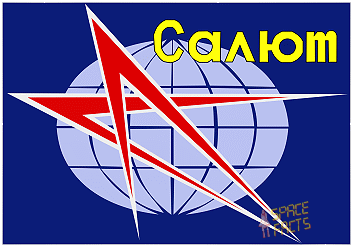 |
![]()
Launch, orbit and landing data
walkout photo |
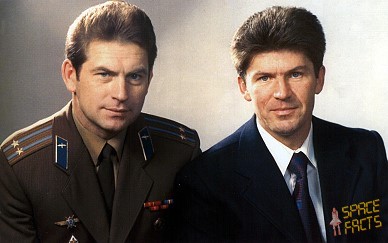 |
|||||||||||||||||||
alternative crew photo |
alternative crew photo |
|||||||||||||||||||
alternative crew photo |
alternative crew photo |
|||||||||||||||||||
alternative crew photo |
alternative crew photo |
|||||||||||||||||||
Crew
| No. | Surname | Given names | Position | Flight No. | Duration | Orbits | |
| 1 | Kovalyonok | Vladimir Vasiliyevich | Commander | 1 | 2d 00h 44m 45s | 32 | |
| 2 | Ryumin | Valeri Viktorovich | Flight Engineer | 1 | 2d 00h 44m 45s | 32 |
Crew seating arrangement
|
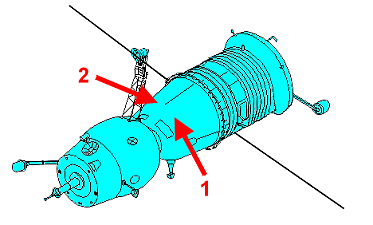 |
|
||||||||||||
Backup Crew
|
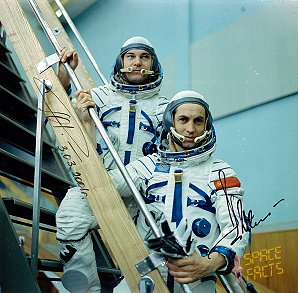 |
|||||||||||||||
alternative crew photo |
Hardware
| Launch vehicle: | Soyuz-U (No. D15000-103) |
| Spacecraft: | Soyuz 25 (7K-T No. 42) |
Flight
|
Launch from the Baikonur Cosmodrome and
landing 185 km northwest of Tselinograd. The spacecraft approached the station the next day, and it contacted the forward port, but Soyuz 25 failed to make a hard dock with the station. The cosmonauts told the ground crew that they had attempted to dock four times, but that the contact light failed to come on. While the crew waited in soft dock - the docking system probe was latched onto the Salyut docking drogue, but the probe had failed to retract and bring the craft together - the ground crew studied the problem. On the 20th orbit, Vladimir Kovalyonok undocked the Soyuz, and attempted to dock for the fifth time during the 23rd orbit, but failed again. The decision was made to return to Earth, as the Soyuz was equipped with batteries designed to last about two days, and the craft lacked fuel to attempt to dock with the port on the opposite side of the station. Another problem of this mission was, that only rookies flew. The rules were changed, so that a rookie only could fly together with a veteran cosmonaut. Until the mission of Soyuz TM-19 this rule was not changed again. The Soyuz spacecraft is composed of three elements attached end-to-end - the Orbital Module, the Descent Module and the Instrumentation/Propulsion Module. The crew occupied the central element, the Descent Module. The other two modules are jettisoned prior to re-entry. They burn up in the atmosphere, so only the Descent Module returned to Earth. The deorbit burn lasted 188 seconds. Having shed two-thirds of its mass, the Soyuz reached Entry Interface - a point 400,000 feet (121.9 kilometers) above the Earth, where friction due to the thickening atmosphere began to heat its outer surfaces. With only 23 minutes left before it lands on the grassy plains of central Asia, attention in the module turned to slowing its rate of descent. Eight minutes later, the spacecraft was streaking through the sky at a rate of 755 feet (230 meters) per second. Before it touched down, its speed slowed to only 5 feet (1.5 meter) per second, and it lands at an even lower speed than that. Several onboard features ensure that the vehicle and crew land safely and in relative comfort. Four parachutes, deployed 15 minutes before landing, dramatically slowed the vehicle's rate of descent. Two pilot parachutes were the first to be released, and a drogue chute attached to the second one followed immediately after. The drogue, measuring 24 square meters (258 square feet) in area, slowed the rate of descent from 755 feet (230 meters) per second to 262 feet (80 meters) per second. The main parachute was the last to emerge. It is the largest chute, with a surface area of 10,764 square feet (1,000 square meters). Its harnesses shifted the vehicle's attitude to a 30-degree angle relative to the ground, dissipating heat, and then shifted it again to a straight vertical descent prior to landing. The main chute slowed the Soyuz to a descent rate of only 24 feet (7.3 meters) per second, which is still too fast for a comfortable landing. One second before touchdown, two sets of three small engines on the bottom of the vehicle fired, slowing the vehicle to soften the landing. The premature return to Earth was without additional more problems. |
Photos / Graphics
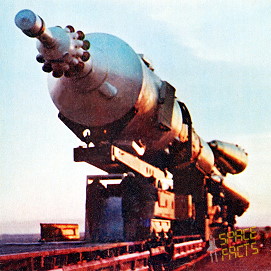 |
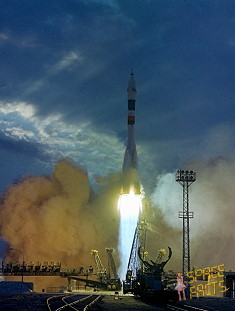 |
 |
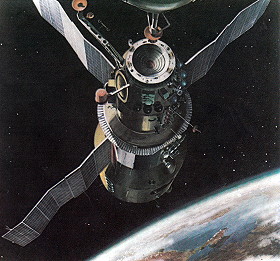 |
| © |  |
Last update on May 13, 2021.  |
 |